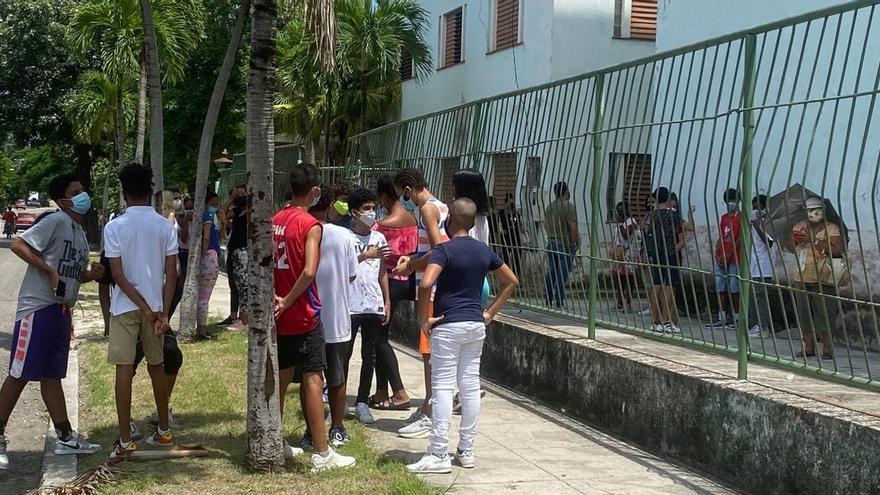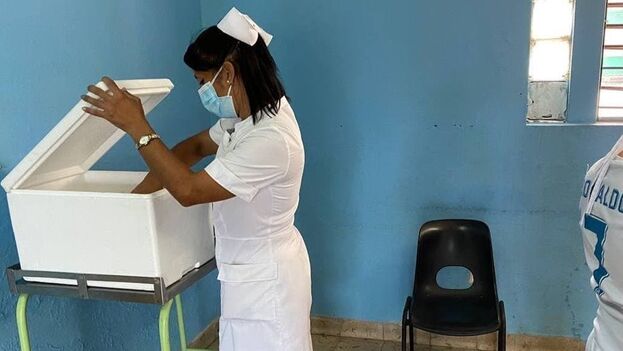
![]() 14ymedio, Luz Escobar, Havana, 12 September 2021 — The time of a working day, the itchiness of the skin in the sun and the long faces of children tired of waiting are part of what I experienced and observed during the vaccination process for my two daughters last Friday. A day that began with the hope of immunization but it was twisted with the inefficiency and slowness of the process.
14ymedio, Luz Escobar, Havana, 12 September 2021 — The time of a working day, the itchiness of the skin in the sun and the long faces of children tired of waiting are part of what I experienced and observed during the vaccination process for my two daughters last Friday. A day that began with the hope of immunization but it was twisted with the inefficiency and slowness of the process.
Among the parents who took their children to be vaccinated against covid-19 at the José Luis Arruñada school in Havana that day, uncertainty and complaints reigned. However, the criticisms went more to organizational problems than to questioning the effectiveness of the Soberana 02 vaccine, developed in Cuba and surrounded by intense official propaganda.
Questions about the process ranged from how to access the vaccination site to the lack of outdoor seats, on a day marked by the heat and the discomfort of a long wait. However, the line — slow and at times paralyzed — was a scene for the exchange of wishes and fears before a possible start of face-to-face classes.
Those who came to the school, from the Plaza de la Revolución municipality, were called by a notice that, like me, reached them by phone or through the WhatsApp group that parents keep with teachers. In the message they detailed schedules by group. Everything seemed very organized, but the reality was very different.
“We are behind schedule because the vaccine was almost two hours late,” said several teachers as soon as the first complaints began to rise. “We are slow because some kids had a reaction to the vaccine and we had to stop to attend to them,” they explained.
With a single nurse vaccinating, the process lasted for hours and in some cases, families with children in different grades in the school had to wait the equivalent of a full working day to be able to return home with their two children now immunized with this first dose, out of a total of three that children and adolescents are expected to receive.
From early in the morning the students gathered at the door hand in hand with a relative. In the call to come for the vaccine, it was explained that it was an essential requirement to be accompanied by an adult and we were also armed with water bottles, charged cell phone batteries and some snacks. In a few hours there were already dozens of us crowded in front of the school.
The wait began on the sidewalk, outside the extensive building that takes the entire block from Tulipán Street to Lombillo, a school managed more than half a century ago by the Catholic Brothers of La Salle and which for years has housed a primary school and another secondary school, surrounded by a sports area that has been worn out.
In my case I was lucky, because my two daughters, the youngest who is in sixth grade and the oldest who is in eighth grade, were scheduled for the same day. But it was not going to be easy because despite going together they had to be immunized separately, each one at the time assigned to their teaching group. So after waiting they called the younger one and, although I tried to convince the teacher to inject both of them, my words did not persuade her and the older one had to stay outside, sitting on a wall.
Despite the stumble, we were relieved that we had managed to overcome the first obstacle and enter the school. Already in the shade and just after passing the threshold of the door, a woman had the task of spraying a jet of water with chlorine on each hand, a dirty sack splashed with that liquid also served as the “breech step.” In one of the classrooms they had set up a makeshift waiting room with chairs placed five feet apart.

When we entered the vaccination center, the nurse was waiting for the kids in a corner of the room where she had everything ready on a table while another nurse was taking care of registering the batch and making the vaccination card. But first you had to go through another table with a doctor who took the students’ temperature and asked them some questions: Are you allergic to any medications? Do you suffer from any disease? Have you had covid recently? Are you taking antibiotics?
After answering, it was just taking a few steps to where the nurse was and receiving the injection. We had to wait for her to finish with another child, the father took out his cell phone to take a picture and she told him: “You can but please don’t publish it.” “Don’t worry, it’s for Grandpa who doesn’t want to miss out on this moment,” he replied.
My younger girl took a seat and they gave her the first dose of Soberana 02 which will be completed later with a second, allowing 21 days to pass between each one and a third which is with Soberana Plus. Now it was an hour of waiting in the school dining room, to monitor her condition after being immunized.
It was almost noon and my other girl had already passed the time indicated in the summons message. A teacher informed us that they had to stop the process “because some children had raised blood pressure.” So my youngest daughter and I left the regulation wait and went to another line where the high school students were.
Nothing had moved, the clock read 12, and not a single eighth grader had been vaccinated.
Of course, the line of these teenagers did not resemble that of the little kids who came hand in hand with their parents. They met in groups to talk while their parents stood in line and of course each greeting was mediated by a hug and a kiss: Who controls the euphoria and hubbub of 13- and 14-year-old students who have not seen each other in person for months?
But the three of us were hungry and we crossed Tulipán to have a snack in a cafe that is right next to the school. Although we delayed, when we returned the panorama was the same. At half past two they began to organize the line for the eighth grade students and soon it was my daughter’s turn because she was one of the first.
The process was almost the same, the difference being that they did not allow us to go to the dining hall to accompany them during the observation time. “But and that’s why, the objective of them coming with their parents is that, that we accompany them, they are not going to complain so you have to keep an eye on them in case they feel bad,” protested a mother but the teacher in front was uncompromising: “You have to wait outside.”
When the hour passed, we went home and when we left we saw that there were still dozens of students outside waiting in the inclement September sun. The process that should have occurred in one morning lasted until late in the afternoon, unnecessarily expanding the physical interaction between the kids.
After the vaccination, the only complaint that has come from the girls, especially the younger girl, is a severe pain in the arm. We went to see the doctor, but she commented that this is normal and that it was more of a warning sign if there was redness on the arm or if the area where she received the injection became very hard.
Speaking later with other mothers who also went through the same process this Friday, I was able to hear quite similar stories: delay in the arrival of vaccines, little organization and, in general, slowness in the process.
“The worst thing is that we still have to go through this two more times and I don’t think it will be any different,” one pessimist commented. “For the next time you have to bring an umbrella, a bench and more cold water,” she said.
____________
COLLABORATE WITH OUR WORK: The 14ymedio team is committed to practicing serious journalism that reflects Cuba’s reality in all its depth. Thank you for joining us on this long journey. We invite you to continue supporting us by becoming a member of 14ymedio now. Together we can continue transforming journalism in Cuba.
